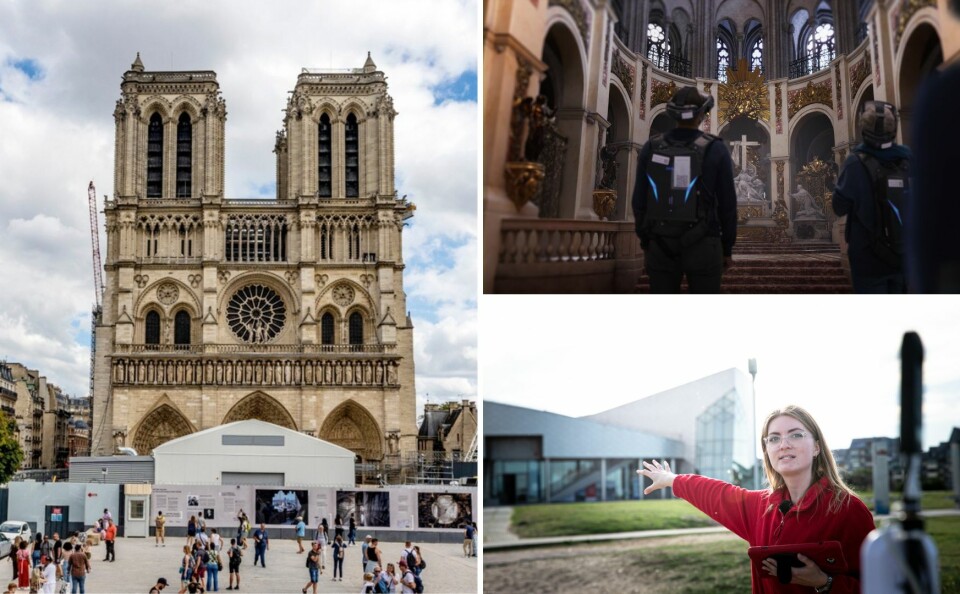-
French ski resorts report excellent Christmas despite less snow than last year
Bookings are up and non-snow related activities are also on the rise
-
Duck Cold! Four French phrases to use when it is freezing outside
We remind you of French expressions to use to describe the drop in temperature
-
When and why do we say le moral dans les chaussettes?
We explore this useful expression that describes low spirits
How virtual reality is creating new opportunities for French tourism
Tourists can explore Notre-Dame, the Eiffel Tower and Juno beach without setting foot in the country

Tourist sites are adopting innovative technologies to let people experience them even when visiting is physically impossible.
It means, for example, that visitors to Paris can admire Notre-Dame Cathedral, which is not due to reopen to the public until December 2024, thanks to virtual reality (VR).
The Eternal Notre-Dame experience allows you to explore the cathedral over a span of more than 800 years, from the beginning of construction in the 12th century to the fire in 2019 and its future reopening.
Visitors are equipped with a VR headset and backpack inside a 500m² space.
Read more: General leading Notre-Dame restoration in Paris dies on mountain hike
Read more: France will win Notre-Dame rebuild challenge, says general in charge
Interact with figures from history
The experience is designed to appeal to both “those who live a stone’s throw from Notre-Dame, and those who have never seen it in their life”, said Louis-Xavier Nicolas, communications director at Amaclio, one of the project creators.
It lasts 45 minutes, and features interactions with a number of characters who have contributed to Notre-Dame over the centuries, including Guillaume d’Auvergne (Bishop of Paris from 1228), carpenters and stonemasons, while a VR version of architect Eugène Viollet-le-Duc explains the choices behind his 19th-century restoration.
“It’s much more powerful for the viewer than a simple narrator,” Mr Nicolas said.
‘No other VR experiences are this developed’
The historical attention to detail and presence of a virtual guide set the experience apart from other VR projects, he said, while there is also an important interactive element.
“It’s the only experience in the world which is this developed in terms of roaming around: visitors can move about and explore Notre-Dame while the guide is speaking.”
The experience is currently available at two Paris sites: under the square of Notre-Dame and at La Défense.
Organisers expect to replicate it in Asia and the US in the coming months and are looking into producing similar experiences for other monuments.
30% of ticket price goes to restoration
Mr Nicolas does not, however, believe technology can replace the real-life experience.
“The most important thing is the stone, the reality. This is complementary, and allows us to experience past events that are difficult to comprehend during traditional visits.”
The production was created by the Orange Group, Amaclio Productions (known for producing light and sound shows such as La Nuit aux Invalides), artistic director Bruno Seillier and VR company Emissive.
The visit costs €30 (reduced tickets at €20), with 30% going towards organisations overseeing the cathedral’s restoration.
Other tourist sites offer virtual experiences for people who are unable to travel.
Juno Beach visits for Canadians who cannot travel
The Juno Beach Centre, on the site in Normandy where 14,000 Canadian and 8,000 British soldiers landed on D-Day, offers live virtual tours with a Canadian guide.
The aim is to make the centre more accessible, both to Canadians who are unable to make the journey for financial reasons and to people who would have difficulty accessing the bunkers.
The Covid pandemic, which forced the centre to close for 20 weeks, inspired them to think more seriously about solutions.
Catherine Quintal, who oversees the centre’s tour guides, said: “Part of our mission is imparting the memory to as many people as possible.”
It also contributes to the centre’s sustainable development strategy by limiting its carbon footprint.
Read more: Tributes made as last known Royal Navy Dunkirk veteran dies
360-degree live video with guide
It teamed up with Caen-based company Twelve Solutions, which developed a cart fitted with a computer and a 360-degree camera. The guide can wheel this around the site and beach.
Visitors at home can explore the view while the guide is speaking, and ask questions, which will appear on the guide’s tablet.
The only part that is pre-recorded is the bunker visit, as the walls are too thick for the wifi to work.
“We had to think how to make the tour more relevant. We didn’t just want to have a guide standing in front of a camera,” Ms Quintal said.
The main issue, she said, has been internet problems, but the centre now sends users a link to test their connection.
“It’s not the same as a Zoom call. The 360-degree live video requires a better connection.”
Région Normandie financed half of the €40,000 investment.
Since the start of the year, there have been two tours per week in English and two in French.
The virtual tours are paused over the summer and during school holidays to focus on in-person tours, but resume in September.
Read more: Should Nazi defences be preserved or forgotten along French coast?
Eiffel Tower and Besançon use technology for visits
Technology can also be used to enhance in-person visits.
Earlier this year, a four-legged robot named Rocket made its way through Besançon’s 17th-century citadel, capturing 360-degree images that will be digitalised.
Visitors will eventually have access to augmented reality experiences, allowing them to see what the fortress was like when Vauban first designed it, for example.
The Eiffel Tower also unveiled an augmented reality experience this year to mark the centenary of Gustave Eiffel’s death.
Related articles
French attraction moves to tackle problem over overtourism
Tourism reversal in France: southerners head north to cool off
Boost in US, Canadian and Asian visitors to France this summer
























